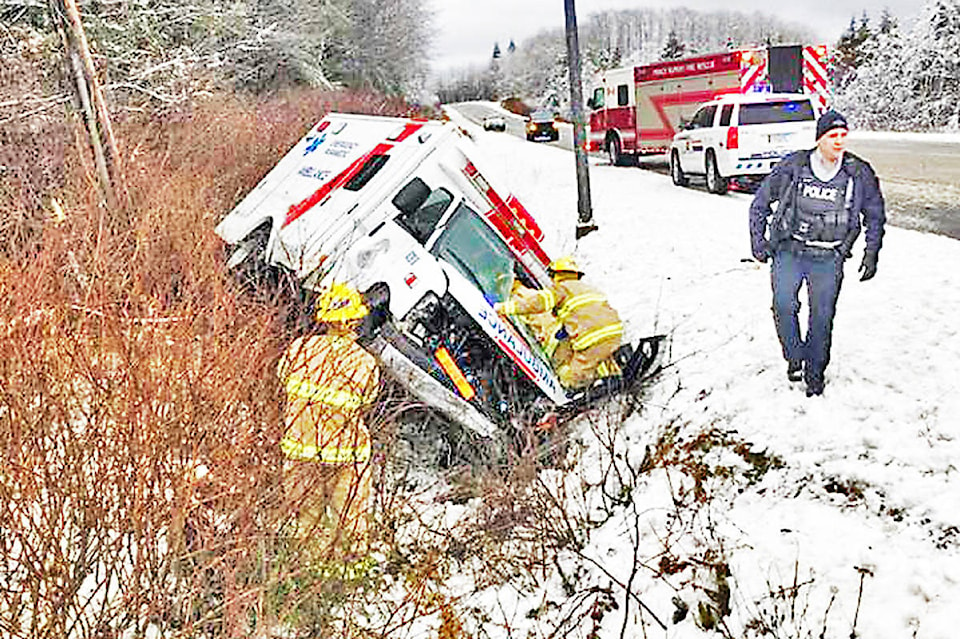Four-wheel drive vehicles may be a staple for northern residents, especially in the winter, but that doesn’t extend to the B.C. Ambulance Service.
That news comes from the service in response to a District of Houston request that ambulances be either four-wheel or all-wheel drive.
“It is a major safety risk that our emergency services vehicles may be unequipped to reach patients or hospital destinations in other communities in adverse weather conditions,” the council stated in a briefing note prepared for health minister Adrian Dix.
For Houston, that’s critical because while it has a health centre, the nearest hospitals are either approximately one hour’s drive east to Burns Lake or one hour’s drive west to Smithers.
“Many elderly residents may be unable to regularly shovel snow from their driveways, meaning that ambulances may have restricted access to private residences,” the Houston council briefing note added.
And many residents live on rural, unpaved roads that may be steep or unmaintained, the note said.
While this may be of concern to areas in the north that receive higher amounts of snow, North Coast MLA Jennifer Rice and the BC Emergency Health Services (BCEHS), say the lack of four-wheel drive ambulances are not a concern for residents in Prince Rupert and Haida Gwaii where wet roads and ice are more common.
Last winter saw an incident off of Highway 16 between Rupert and Port Edward where an ambulance skid off the icy road and crashed. However, according to BCEHS four-wheel drive does not help in icy conditions.
“Our current rural ambulances are well equipped to drive in winter and offer benefits and practical advantages of two-wheel drive. A 4x4 vehicle is not any further help to crews in icy conditions,” Shannon Miller Communications Officer, BCEHS.
READ MORE: Ambulance crashes along Highway 16
Miller did add that the service’s ambulances are equipped with snowflake-rated tires and do carry chains.
“On Haida Gwaii, the main issue in regard to ambulances I’ve heard has been around staffing challenges as well as the challenge that the reduced Kwuna ferry service has caused with patient transport during the evenings,” she said.
The elimination of the second ferry shift has meant that the Canadian Coast Guard has had to step up and provide patient transport to and from Moresby and Graham islands during the evenings. The vessel is an open boat and not designed for transporting immobile people in often adverse weather conditions, Rice explained.
The restoration of the Kwuna ferry service, although delayed in implementation is expected to alleviate Haida Gwaii’s patient transport challenge during the evenings.
The ambulance service did experiment with four-wheel drive vehicles in rural and northern areas, and some are still in service, but overall found them unsuitable, Miller said.
“The primary reason the trial was not expanded is the 4x4 ambulances presented a safety risk for our paramedics,” she said.
“The nature of a 4x4 ambulance means an increased floor height, significantly increasing the risk of injury while loading and unloading the ambulance. Musculoskeletal injuries are by far the leading cause of injury for paramedics.”
Paramedics also found the 4x4 chassis to have a much stiffer and rougher riding suspension, affecting the comfort of patients being transported in the unit.
Specific to rural areas, the service has introduced ambulances with a longer wheelbase chassis which allows for a larger fuel tank to increase range and provide additional storage space for winter gear for the paramedics, she said.
“As we continue our regular replacement of vehicles, more of these ambulances will be in rural areas such as Houston,” Miller said.
And when ambulance crews do need assistance during winter weather conditions, such as dealing with snowed-in rural driveways, they’ll call on other first responder services.
BCEHS had nine four wheel drive ambulances in their provincial fleet. One is used for training and learning and the others are in Burns Lake, Dease Lake, Seton Portage, Zeballos, Gold Bridge, Bella Coola, Lillooet and Pemberton.
READ MORE: Night vision for Rupert’s air ambulances
Jenna Cocullo | Journalist
Jenna Cocullo
Send Jenna email
Like the The Northern View on Facebook
Follow us on Twitter
